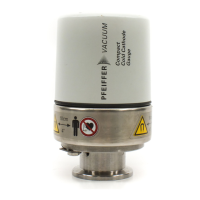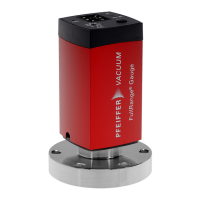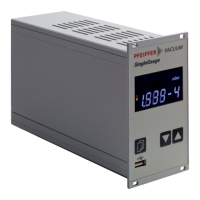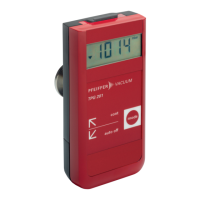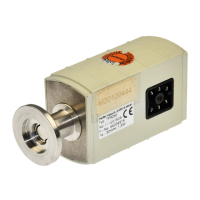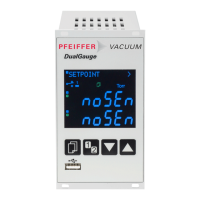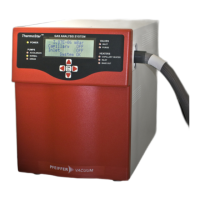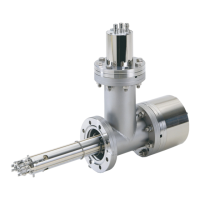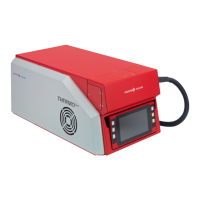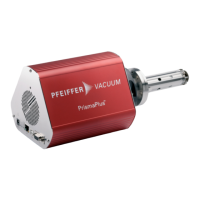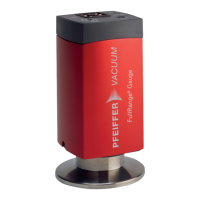Do you have a question about the Pfeiffer Vacuum IKR 270 and is the answer not in the manual?
Document describes product function and safety information according to valid directives.
Lists relevant documents for the product, including brief instructions and declarations.
Details the different part numbers and designations for the product variants.
Identifies personnel for whom the operating instructions are intended.
Explains document conventions like instructions, pictographs, stickers, and abbreviations.
Lists trademarks used in the document.
Explains the risk levels and information levels used in the document for safety.
Provides safety instructions related to product life stages and risks during installation.
Outlines general safety precautions and responsibilities for handling the product.
Defines the intended use of the gauge and its measurement range.
Lists specific examples of misuse that invalidate warranty and liability claims.
Defines Pfeiffer Vacuum's responsibilities and warranty conditions.
Lists requirements for product owners to ensure safe operation.
Specifies the required qualifications and training for personnel working with the product.
Details qualifications for mechanical and electrotechnical work and trained individuals.
Outlines advanced training courses for maintenance levels.
Informs about advanced training courses offered by Pfeiffer Vacuum.
Lists operator requirements for observing documents and data.
Describes the gauge's function and the warning about magnetic fields.
Explains the LED indicator on the gauge for operating status.
Guides on how to identify the product using its rating plate.
Lists the items included in the scope of delivery.
Provides instructions and recommendations for safe transportation of the product.
Gives guidelines for proper storage to prevent damage.
Details safety precautions and steps for establishing the vacuum connection.
Explains how to handle and install the magnetic unit of the gauge.
Covers safety warnings and procedures for establishing the electrical connection.
Explains how to convert the measuring signal to pressure using constants and tables.
Details how to determine effective pressure using calibration factors for different gases.
Explains the ignition delay characteristic of cold cathode measuring systems.
Discusses contamination effects, warranty implications, and how to influence contamination levels.
Provides step-by-step instructions for dismantling the gauge.
States that the gauge is maintenance-free and how to replace a faulty unit.
Lists required tools and precautions for disassembling the gauge.
Details safety precautions and procedures for cleaning gauge components.
Provides instructions and safety warnings for reassembling the gauge.
Provides guidelines and warnings for shipping contaminated or non-contaminated products.
Provides information on materials that can be recycled and disposal procedures.
Details steps for dismantling and disposing of gauges.
Explains how to utilize Pfeiffer Vacuum's service options for maintenance and repair.
States policies regarding the acceptance and handling of contaminated products.
Guides on how to order original spare parts using part numbers.
Describes available accessories like measurement cables and connectors.
Lists accessories with their corresponding order numbers.
Provides conversion tables for pressure units and gas throughput.
Details measured and pressure values, output signals, and impedance.
Lists electrical specifications including supply voltage, current, and connection details.
Provides internal volume and weight specifications for the product.
Details ambient conditions such as humidity, temperature, and altitude.
Specifies operating, storage, and bake-out temperatures.
Lists materials that come into contact with process media.
Shows dimensional drawings of the product in millimeters.
Document describes product function and safety information according to valid directives.
Lists relevant documents for the product, including brief instructions and declarations.
Details the different part numbers and designations for the product variants.
Identifies personnel for whom the operating instructions are intended.
Explains document conventions like instructions, pictographs, stickers, and abbreviations.
Lists trademarks used in the document.
Explains the risk levels and information levels used in the document for safety.
Provides safety instructions related to product life stages and risks during installation.
Outlines general safety precautions and responsibilities for handling the product.
Defines the intended use of the gauge and its measurement range.
Lists specific examples of misuse that invalidate warranty and liability claims.
Defines Pfeiffer Vacuum's responsibilities and warranty conditions.
Lists requirements for product owners to ensure safe operation.
Specifies the required qualifications and training for personnel working with the product.
Details qualifications for mechanical and electrotechnical work and trained individuals.
Outlines advanced training courses for maintenance levels.
Informs about advanced training courses offered by Pfeiffer Vacuum.
Lists operator requirements for observing documents and data.
Describes the gauge's function and the warning about magnetic fields.
Explains the LED indicator on the gauge for operating status.
Guides on how to identify the product using its rating plate.
Lists the items included in the scope of delivery.
Provides instructions and recommendations for safe transportation of the product.
Gives guidelines for proper storage to prevent damage.
Details safety precautions and steps for establishing the vacuum connection.
Explains how to handle and install the magnetic unit of the gauge.
Covers safety warnings and procedures for establishing the electrical connection.
Explains how to convert the measuring signal to pressure using constants and tables.
Details how to determine effective pressure using calibration factors for different gases.
Explains the ignition delay characteristic of cold cathode measuring systems.
Discusses contamination effects, warranty implications, and how to influence contamination levels.
Provides step-by-step instructions for dismantling the gauge.
States that the gauge is maintenance-free and how to replace a faulty unit.
Lists required tools and precautions for disassembling the gauge.
Details safety precautions and procedures for cleaning gauge components.
Provides instructions and safety warnings for reassembling the gauge.
Provides guidelines and warnings for shipping contaminated or non-contaminated products.
Provides information on materials that can be recycled and disposal procedures.
Details steps for dismantling and disposing of gauges.
Explains how to utilize Pfeiffer Vacuum's service options for maintenance and repair.
States policies regarding the acceptance and handling of contaminated products.
Guides on how to order original spare parts using part numbers.
Describes available accessories like measurement cables and connectors.
Lists accessories with their corresponding order numbers.
Provides conversion tables for pressure units and gas throughput.
Details measured and pressure values, output signals, and impedance.
Lists electrical specifications including supply voltage, current, and connection details.
Provides internal volume and weight specifications for the product.
Details ambient conditions such as humidity, temperature, and altitude.
Specifies operating, storage, and bake-out temperatures.
Lists materials that come into contact with process media.
Shows dimensional drawings of the product in millimeters.
| Brand | Pfeiffer Vacuum |
|---|---|
| Model | IKR 270 |
| Category | Measuring Instruments |
| Language | English |
